BLM releases final assessment of Lava Ridge Wind Project
The Bureau of Land Management (BLM) released their final environmental review of the Lava Ridge Wind Project on Thursday, June 6—but not without significant changes to the original proposal. The Final Environmental Impact Statement (EIS) is over 2,500 pages, and we’re just beginning to digest it. We find it prudent to, at the very least, provide you with some clarity in the wave of social media and news stories that are popping up. We look forward to fully reviewing this assessment and collaborating with others to generate support for projects that strike the right balance between advancing clean energy goals and protecting Idaho’s cultural, historic, recreational, environmental, and wildlife values. In that spirit, you will see a deep dive into the specifics of this assessment and project proposal soon. After our initial review of the Final EIS, it seems that the BLM has addressed many of the concerns raised by local stakeholders as well as the Idaho Conservation League. This project is roughly half the size as originally proposed, with changes that can better avoid, minimize, and mitigate impacts. Of all the options the BLM initially looked at, the new alternative is even more restrictive than the most restrictive alternative initially examined. Some topline changes that were implemented:
- 49% reduction in general project area, 40% reduction in number of wind turbines, 50% reduction in ground disturbance, and 53% reduction in total access roads.
- Stronger protections for a pronghorn critical migratory corridor and mule deer wintering area.
- Restrictions on construction that prevent activity during key periods of migration.
- A region-wide analysis of greater sage grouse will be conducted to make sure future energy development does not imperil their population numbers in the Mountain West.
- Multi-phased construction to limit impacts to livestock operations. Ranchers are getting new wells and troughs that can be used for cattle operations and firefighting crews will have more water access points moving forward.
- Cultural resource impacts (e.g. Wilson Butte Caves, Sid Butte, Minidoka Historic Site) are significantly reduced, but not eliminated. For example, less than 20% of the original project area had detailed ground-based surveys to identify cultural resources.
- The setback for the nearest turbine to the Minidoka National Historic Site increased from 2.5 miles to 9 miles away. The maximum turbine height was also reduced from 770 ft to 660 ft.
Images included in the EIS simulate the viewshed from Minidoka. The first image shows the existing view from the Minidoka Historic Site. The second image shows a simulation of the view under the original proposal, and the third image shows a simulation under the preferred alternative.

 Again, ICL will be doing a full review of the final EIS and dive deeper into the impacts. We will do so while fully recognizing that Idaho needs more renewable energy projects that both benefit our local communities and transition us away from dirty fossil fuels. When they strike the right balance, renewable projects have the potential to protect the Idaho way of life for current and future generations and help put our state and country on a path toward a climate-resilient future.Stay tuned for more on the proposed Lava Ridge Wind Project from ICL in the coming weeks.
Again, ICL will be doing a full review of the final EIS and dive deeper into the impacts. We will do so while fully recognizing that Idaho needs more renewable energy projects that both benefit our local communities and transition us away from dirty fossil fuels. When they strike the right balance, renewable projects have the potential to protect the Idaho way of life for current and future generations and help put our state and country on a path toward a climate-resilient future.Stay tuned for more on the proposed Lava Ridge Wind Project from ICL in the coming weeks.

